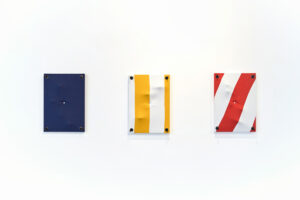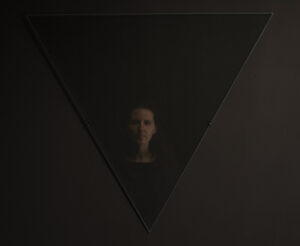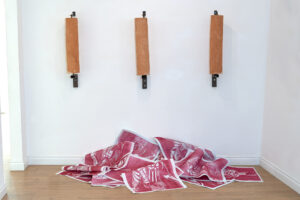On April 15th, in the spaces of the B # S Gallery in Treviso and in digital version on the website www.bsidewar.org, the collective exhibition “FROM A COMMON PAST”, curated by the cultural association IoDeposito, opened. The protagonists of the exhibition are the works created with different types of media (including installations, sound, video art, painting, collage and an archive section dedicated to performance art) by 11 international artists who have investigated the legacies in the present of traumatic past events (European and beyond), such as wars, dictatorial regimes and the darkest drifts of the latter, such as the holocaust.
With the works of Dan Allon (Israel), Marcela Avellaneda (Colombia), Manca Bajec, Boris Beja (Slovenia), Mircea Ciutu (Romania), Jason File (USA), Sylvia Griffin (Australia), Katarzyna Pagowska (Poland), Vasilisa Palanina, Lesya Pchelka and Uladzimir Hramovic (Belarus), the exhibition will be open in the gallery (but by reservation only) and online until May 29th.
“The presence through the generations of ancient or recent traumas related to wars has an impact that weighs on life and relationships, not only among neighboring peoples but also within societies. So taking them back, reworking them and archiving them, lightens this weight, which otherwise is handed down from generation to generation”. These are the words of the psychoanalyst Paolo Fonda, pronounced in a 2015 interview, which explain the fundamental importance of the collective re-elaboration of a traumatic experience, useful for “neutralizing” the negative impact, otherwise destined to be perpetrated. For its “ability to probe the places where rationality does not reach and bring out the unconscious contents”, it is precisely art, according to Fonda, that constitutes one of the most suitable tools to illuminate the dark corners of traumatic luggage humanity carries with it, transforming them into a shared narrative and teaching.
Many of the works that animate the collective exhibition From a common past are the result of personal and family experiences connected to the dramatic events which, especially in Europe of the 20th and 21st centuries, have upset the fate of entire populations: totalitarian regimes (with the drifts that they have entailed, such as anti-Semitism, anti-Gypsyism, xenophobia), revolutions, Shoah and other exterminations, and the violence with which citizens of some parts of the world, even today, are forced to live daily.
With the works on display, the artists have identified and reworked the “gray areas” that these events continue to project onto the contemporary world, invisible and never dissolved knots that can act – at an unconscious level – even on the new generations. While some have been directly touched by these events, others have made the theme of conflicts and the way in which they are narrated and remembered – through rituals and memorials – the focus of their research.
The exhibition itinerary progresses by gradually widening its geographical and semantic panorama: if in the first group of works, which includes those by Lesya Pchelka and Vasilisa Palanina, Manca Bajec, Katarzyna Pagowska and Sylvia Griffin, the protagonist is the Jewish holocaust, in the second, with the works of Marcela Avellaneda, Jason File, Mircea Ciutu and Boris Beja, the vision extends to include other holocausts and the narration of slices of life of Nations in which the wounds caused by political choices are open or not yet heal. Recurring, in this second group of works, is also the image of the bare earth and burials in mass graves.
Always underlying in From a common past are the universal themes of life and death. Not surprisingly, the exhibition is closed by the “mobile” installation by Boris Beja, with its archetypal representation of a dance: reflection on the eternal flow of time, conveys a message of hope which, in the incessant progress of history, the memory of the past can always be kept alive.
Also represented in the exhibition, through a digital archive, are 4 performances by the Israeli artist Dan Allon, where the protagonist is the archetypal figure of an imaginary dictator, of which the artist, for several times and for long periods of time (also up to a month) has literally dressed up. Through extensive research that has seen him study, through films and images, also the common traits and “aesthetic charms” of dictators and political generals, with particular reference to the figures of Idi Amin Dada (Uganda) and Mu’ammar Gaddafi (Libya), Allon reflected on the dangerous power of charismatic leaders to influence the masses, on totalitarian regimes and on the systems of political repression put in place by the latter.
The exhibition is part of the ArtForRemembrance project, led by the cultural association IoDeposito, co-financed by the European Union’s “Europe for Citizens” program.
Info:
FROM A COMMON PAST
15/04/2021 – 29/05/2021
B#S GALLERY – Via Isola di mezzo 3/5, Treviso
Only by appointment
To book a visit to the exhibition:
magdalena.dokowska@iodeposito.org
Online exhibition: www.bsidewar.org
 Mircea Ciutu, “Reeducation”, detail, 2018. B#S Gallery, Treviso. Ph. Mattia Carrer
Mircea Ciutu, “Reeducation”, detail, 2018. B#S Gallery, Treviso. Ph. Mattia Carrer
 Jason File, “The hole truth”, B#S Gallery, Treviso. Ph. Mattia Carrer
Jason File, “The hole truth”, B#S Gallery, Treviso. Ph. Mattia Carrer
 Katarzyna Pagowska, “Black Triangle”, 2017
Katarzyna Pagowska, “Black Triangle”, 2017
 Boris Beja, “Clay Dance”, B#S Gallery, Treviso. Ph. Mattia Carrer
Boris Beja, “Clay Dance”, B#S Gallery, Treviso. Ph. Mattia Carrer
Historian of contemporary art, she lives and works in Venice. Contributor for sector magazines, press officer and content creator, she is also involved in the organization and communication of a project of artist residences in Piedmont (Italy).






NO COMMENT